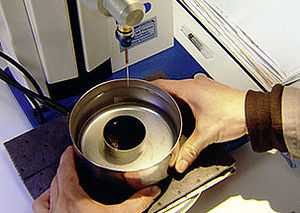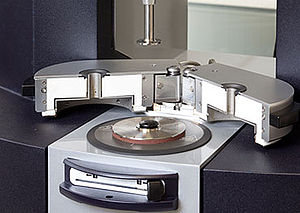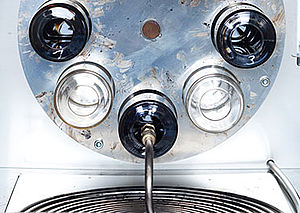Technical
Our technical work breaks down into Testing, Industry Innovations, Specifications and Standardisation.
Various fundamental test methods are used for the technical classification and assessment of the different bitumen types which, in the first instance, determine the consistency of the bitumen in different temperature ranges.
Our Technical Information Sheets provide latest guidance on testing to achieve reliable results and ultimately efficient use of bitumen. You can find them all here!
Eurobitume contributes to the development of standards for test methods and products by participation in CEN working groups and national standardisation bodies to ensure that bitumen specifications are fit for purpose. Having European standards helps everyone involved in the bitumen industry – harmonised product standards are the basis for defining the consistent and effective specifications for supply of bitumen across Europe.
New test methods are developed to characterise the product that we see in our daily lives. Demand is continuously rising, for better roads or new asphalt mixtures – which need better performing bituminous binders. The topic of complex binders is at the heart of the ongoing discussion about the next stage of European product standards.
Testing
Reliable and accurate bitumen testing is critical in ensuring both compliance with specifications and performance in service. The test methods used for bitumen can be broadly sub-divided into two categories: empirical and performance-related. Currently, only the empirical test methods are used for European product standards and are used to determine consistency at different temperature ranges and their durability. Empirical test methods have been in use for many years – in some cases over 100 years! Performance-related tests are not currently used in product standards on European, but on national level, and it is expected that they will be a significant part of future product standards.
Our Technical Information Sheets provide latest guidance on testing to achieve reliable results and ultimately efficient use of bitumen. You can find them all here!
-

This method, under European standard EN 1427, serves to test the behaviour of bitumen at elevated service temperatures. The temperature is determined at which a layer of bitumen, in a brass ring, experiences a certain deformation under the weight of a steel ball as the temperature rises. This test method has been used for more than one hundred years.
Technical Information Sheet -

A test method that has been used for decades, which is now described in EN 1426. Needle penetration is determined by the depth, measured in 1/10 mm, to which a 100 g needle penetrates in 5 seconds into the bitumen at a temperature of 25 °C. It serves to test the behaviour of bitumen at intermediate service temperatures. This test method is suitable for all types of bitumen.
Technical Information Sheet -

Penetration Index is not a test method as such, but obtained by calculation from the Ring and Ball Softening Point and Needle Penetration. The calculation formula is based on the assumption that the penetration of the binder is 800 0,1 mm at its softening point. This is correct for most conventional binders but not for Polymer Modified and special binders. The original calculation was based upon determination of the needle penetration at different temperatures.
-

The determination of the Fraass breaking point is described in the test standard EN 12593. It describes the transition of the binder from a flexible to a brittle condition and provides the temperature at which a thin bitumen layer on a steel sheet cracks during uniform cooling when it is bent under defined conditions. The test indicates the behaviour of the bitumen at low service temperatures.
-

The test for elastic recovery is applicable to binders modified with elastomers, and serves to demonstrate the modification of the binder. The sample is stretched at a fixed temperature and speed to a maximum of 20 cm and then severed. After a prescribed period of time, the degree of elastic recovery is determined relative to the original length.
-

The further development of the well-known ductility test serves to determine the cohesive characteristics of a binder, the test is used in the standard for polymer-modified bitumen. A sample is stretched at a fixed temperature and speed and the necessary tensile force is measured and recorded continuously. The data are used, among other things, to calculate the deformation energy, the maximum tensile force or the stretch length of the sample until breakage. Further options for interpretation of the data are currently being researched and discussed.
Technical Information Sheet -

The Dynamic Shear Rheometer (DSR) is an instrument which is used to test bitumen properties under a variety of loading conditions and temperatures. The DSR can apply a controlled stress to the sample and measures the response, from which it can calculate properties such as the complex shear modulus G* and phase angle. Testing using the DSR is described in the test method standard EN 14770. Typically, DSR testing is conducted over a range of test temperatures and/or loading frequencies, called temperature and frequency sweep respectively. From the recorded data complex shear modulus G* and its phase angle (δ) at given temperatures/frequencies are calculated.
Technical Information Sheet -

The Dynamic Shear Rheometer (DSR) testing device is also used to perform the Multiple Stress Creep and Recovery Test. This test method is described in the test standard EN 16659 and addresses elastic response and sensitivity to permanent deformation of bituminous binders as well as stress dependence. A sample of binder is placed between two parallel plates and loaded with constant stress for exactly 1,0 s, followed by 9,0 s without any load. Ten creep and recovery cycles are conducted, from which the percent recovery and non-recoverable compliance of the binder are calculated. The test uses different stress levels, hence the name; ‘Multiple-Stress Creep and Recovery Test’.
Technical Information Sheet -

The Bending Beam Rheometer (BBR) is a device to address the behaviour of bitumen at low service temperatures and is described in the test standard EN 14771. The sample is placed under a constant load in a liquid bath at low temperature for a fixed duration. The creep stiffness of the sample is calculated from the applied stress and resultant strain over time. The test provides information on the stiffness of the binder at low temperatures and its ability to dissipate, or relax, the stress.
Technical Information Sheet -

The Rolling Thin Film Oven Test (RTFOT ) is a conditioning process, rather than a test method and is described in EN 12607-1. RTFOT simulates the combined effects of heat and air on a thin film of bituminous binder. The procedure is intended to simulate the ageing that takes place during the mixing and transportation process for hot mixtures. For paving grade binders a reasonable correlation with the bitumen ageing during asphalt mix production is reported. However, the standard conditioning parameters are not necessarily applicable to modified binders, for which the viscosity may be too high to provide a moving film.
-

As with the RTFOT, the PAV ageing is a conditioning process intended to give information about long-term ageing susceptibility. It is usually carried out after RTFOT-conditioning. Although there are still questions about the applicability of this ageing procedure, due to the prolonged high-temperature experienced by the binder, PAV is the current reference long-term ageing procedure used in Europe & the US and is described in EN 14679. The sample is subjected to high air pressure (2,1MPa), applied to a thin film of bituminous binder under elevated temperature for a given time. PAV ageing is intended to simulate the degree of age hardening that the binder will experience over several years in service.
Technical Information Sheet
Industry Innovation
The bitumen industry has a long track record of innovations which aim to improve performance such as resistance to higher road surface temperatures caused by climate change or increase resistance to heavy loads. Other innovations are designed to make bitumen easier to handle by reducing mixing and application temperatures. Recent innovations include technologies to reduce the embodied carbon of bitumen.
Specifications and Standardisation
Having commonly agreed European standards helps everyone involved in the bitumen industry. These standards help specifiers to select the best bituminous binder for each application or end use. They eliminate commercial and technical barriers to trade within the European Union and provide a set of common reference tools for the market, both within the EU and outside. And they make it easier to communicate technical, health, safety, and environmental data at both the European and local level.
Both product standards and test methods are subject to a periodic review process known as the “systematic review” in which comments and suggestions for improvement are considered every 5 five years. Consequently, we also participate actively in the revision of existing and development of new standards, sharing the expertise of our industry.
The Construction Products Regulation
The current European Union’s Construction Products Regulation (CPR), which also covers bitumen, came into force on 1 July 2013. The CPR superseded the previously established Construction Products Directive (CPD). Eurobitume contributed to the revision of the CPR which took place between 2020-2024, with the new regulation to come into force in summer 2024.



